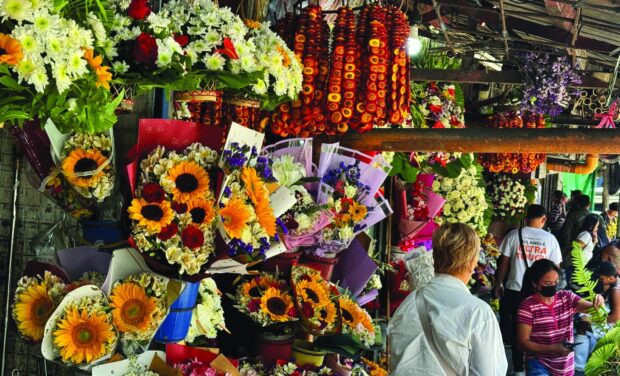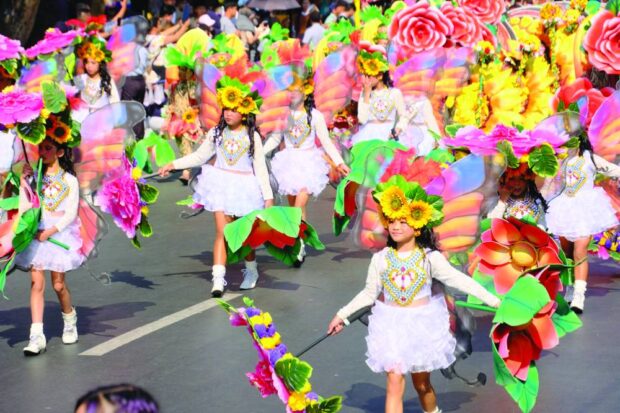Baguio’s floral icons battle it out at Panagbenga

FESTIVE HUES Wearing floral headdresses, and carrying flower-shaped shields and wands, young street dancers from Baguio City are joined by performers from Nueva Ecija, Ilocos Sur, Kalinga
and Pangasinan provinces during the Panagbenga (Baguio Flower Festival) street dancing parade in Baguio City on Saturday. —NEIL CLARK ONGCHANGCO
BAGUIO CITY—Red roses remain the most popular flowers sold in Baguio on Valentine’s Day or any other occasion. White, yellow and occasionally blue daisies, on the other hand, bring the much-needed hues to the largest bouquets arranged by local cut flower vendors.
But only two floral icons are vying to be Baguio’s official flower—the sunflower that stood out in this weekend’s Panagbenga (Baguio Flower Festival) street dancing and float parades, and the “everlasting,” which every Filipino’s parents and grandparents have bought as “pasalubong” or souvenir each time they visited the summer capital decades ago.
Today’s generation associates the city with the sunflower (Tithonia diversifolia or “marapait” to residents), largely because it has been part of Panagbenga’s branding and logo since 1996.
Conceived by civic leaders led by the late lawyer Damaso Bangaoet Jr., the flower festival was designed to help revive the economy by luring back tourists to a restored Baguio shortly after it was devastated by the July 16, 1990, earthquake.
Bangaoet said he was inspired by the Pasadena Rose Parade in the United States, and took the best performative elements from festivals in the Visayas, Brazil’s Rio Carnival and New Orleans’ Mardi Gras.
However, a draft ordinance sponsored by Councilor Betty Lourdes Tabanda on Nov. 24 last year would make everlasting (Xerochrysum bracteatum) the city’s official flower, taking off from the city council’s 1991 Resolution No. 99 which had picked it for being “synonymous with Baguio.”

MAIN ATTRACTIONS Baguio has always been defined by the sunflower which is the brand symbol
of the Baguio Flower Festival, and the everlasting (right) that is turned into souvenir garlands
familiar to frequent visitors for the last 50 years. Both flowers, which can be found in the city
market’s flower stalls, are being eyed as Baguio’s official flower. —KRISTINE VALERIE DAMIAN
Top souvenir
As far back as the 1960s and 1970s, garlands made of dried everlasting or strawflowers were among Baguio’s top-selling souvenirs, according to some of the city’s gardeners, who have been tending to Baguio parks for decades.
Mining companies put up a small everlasting farm inside the Baguio Botanical Garden late last year, after learning that few Baguio gardens have been growing this iconic plant.
Neither the everlasting nor sunflower is endemic to Baguio, according to lawyer Rhenan Diwas, who heads the city environment and parks management office.
Diwas pointed out that the plateau where Baguio stands was a vast grassland populated by Ibaloy cattle raisers before the American colonial government designed and built this city.
“The flowers that have bloomed in the country’s coldest city for the longest time have been the everlasting, snapdragon, red salvia (scarlet sage), the yellow marguerite daisy, and the miniature pitimini roses,” Diwas said, although his office has yet to establish when these flowers were first introduced to the city.
“We have tried to propagate other flowers that grow in Benguet, such as the Benguet lily found at La Trinidad Valley, but I could not make them blossom. The Taiwanese lily seems to thrive far better here than the Benguet lily,” he added.
These Baguio flowers are decorative, but do not have the same majesty as sunflowers, Diwas said.

ROOTS Each year, residents and tourists gather at downtown Baguio to watch the Panagbenga parades and witness how participants, in their flower-inspired costumes, keep the festival’s Cordillera roots. —NEIL CLARK ONGCHANGCO AND KRISTINE VALERIE DAMIAN
Production
Panagbenga has improved the local cut flower market. Most of the flowers sold in the city—and which adorn Panagbenga costumes and floats—were grown in La Trinidad’s Sitio Bahong and in higher elevation Benguet towns like Atok.
Benguet produced around 148 million dozens of roses, gladioli, colored calla lilies, white calla lilies, Shasta daisies, chrysanthemums, anthuriums, statices, baby’s breaths, carnations and asters in 2022, based on data from the Department of Agriculture.
The average production is between 25 and 30 million metric tons of flowers meant for the All Saints’ Day season, Christmas, Holy Week and, for the past 28 years, the annual flower festival.
Cut flower prices should have dropped gradually after Valentine’s Day. The local flower trade had been booming once the COVID-19 pandemic tapered, and had earned each of the traders an average of P40,000 to P150,000 in gross sales on Feb. 14 alone, according to local vendors.
But flower prices continue to rise, benefiting flower growers and vendors, largely due to demand from festival participants, according to Baguio Country Club spokesperson Andrew Pinero during a Feb. 21 briefing organized by the Baguio Flower Festival Foundation.
READ: Baguio blooms anew as Panagbenga crowd seen to make a comeback
Flowers were part of the costumes worn by Saturday’s street dancing performers, made up of six teams of elementary school pupils; the Baguio City National High School; and six delegations from Gabaldon, Palayan City and San Carlos in Nueva Ecija province; Rizal town in Kalinga province; Bani town in Pangasinan province; and Narvacan town in Ilocos Sur.
The three floral carts, 14 medium floats and 13 large floats scheduled to drive down Session Road on Sunday were decorated with fresh flowers.
Many cut flower vendors at the Baguio City Public Market said they considered the sunflower as the official Baguio bloom because the plants were “versatile and tough,” and were among their bestsellers.
‘Invasive’
The ever-present sunflowers in Baguio are actually an “invasive weed,” said biology professor Celia Austria of the University of the Philippines Baguio, which have spread to the city, Benguet and La Union provinces.
Some tourists still seek out everlasting garlands, although supplies have been short because of last year’s typhoons, the vendors said.
“I prefer the everlasting as the official flower, because of its long historic connection with the city,” Diwas said.
Tabanda’s proposed ordinance cites the everlasting’s durability as a symbol for “the strength and resilience of Baguio City.”
According to the measure, the colors of the everlasting “represent the rich culture and countless resources that stimulate the economy and spur growth in all aspects of development.”
“Despite urbanization, the city was able to retain its cultural and indigenous identity by blending tradition with the contemporary,” it said.